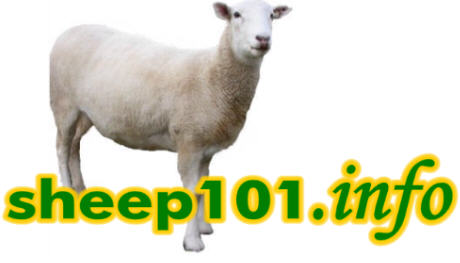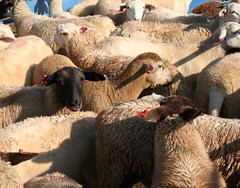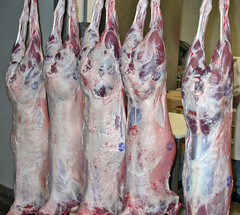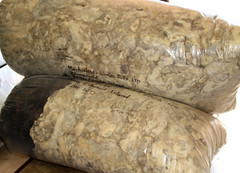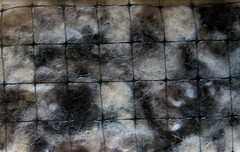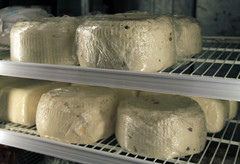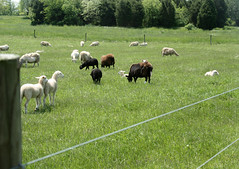This little lamb went to market
Meat
The most important product we get from sheep is meat. Meat
is an important component of our diets, and lamb and mutton supply
us with many of the vital vitamins and proteins we need for healthy
living. Lamb is the meat (flesh) from a sheep that is less than
one year old. Mutton is the meat from a sheep that is over one
year of age. The terms yearling mutton are applied to the meat from a sheep that is between one and two years of age.
|
World meat
consumption |
| Pork |
40 percent |
| Beef |
32 percent |
| Poultry |
22 percent |
| Lamb and mutton |
6 percent |
While sheep meat only accounts for 6 percent of the world's meat
consumption, it is the principle meat in regions of North Africa,
the Middle East, India, and parts of Europe. The European Union
is the world's largest lamb consumer and number one importer of lamb,
whereas 99 percent of the lamb imported originates from Australia
and New Zealand.
Wool
Wool is the product for which sheep are best known. Wool is
widely used in clothing from knitwear such as socks and jumpers
to cloth used for suits and costumes. It is used in the furniture
trade both for making chair covers and for upholstery. Many of
the better carpets produced traditionally and today are made from
wool. Wool is used to fill mattresses. It is used in diverse products,
such as tennis ball covers, pool table baize, and hanging basket
liners.
Alternative uses of wool are increasing. Wool is a very useful
product when oil spills occur. Pads made from wool can be used
to soak up the oil. In 1999 when an oil spill occurred near Phillip
Island, Australia, the Phillip Island penguins were fitted with
wool sweaters. The sweaters helped maintain the tiny penguin's
body heat and prevented them from being poisoned by the oil.
There is a company in the United Kingdom that makes caskets out of wool. Prince Charles is a big supporter of the eco-friendly wool caskets. Several companies are making insulation from wool. Wool has a higher R value than many traditional materials. Mulch pads made from wool offer an environmentally-friendly alternative to plastic mulches.
Bricks reinforced with wool (and seaweed) are less toxic than those reinforced with traditional alternatives. Plus, they're stronger. An entrepreneur in England is making packaging material out of left over wool. Not only are the wool-insulated boxes more environmentally-friendly, but they have out-performed poly-based insulating material, keeping items twice as cool.
Learn about the qualities of wool =>
Lanolin
Raw wool contains 10 to 25 percent grease or "lanolin,"
which is recovered during the scouring process. Lanolin consists
of a highly complex mixture of esters, alcohols, and fatty acids
and is used in adhesive tape, printing inks, motor oils, and auto
lubrication. Lanolin is also used in cosmetics and pharmaceuticals.
Virtually all cosmetics and beauty aids, such as lipsticks, mascara,
lotions, shampoos, and hair conditioners, contain lanolin.
Skins
Sheep skins are removed from the carcasses after slaughter.
They are treated in a process called tanning and made into soft
leather. Sheep skin is commonly used for making the chamois cloth
that you wash your car with. A small number of skins are preserved
as sold as sheepskins, with the wool still attached.
The skins from hair sheep produce the highest quality leather.
This is because the numerous fine wool fibers, as compared to
the lesser number of coarse fibers of the hair sheep, cause the
skin to be more open and loose in texture.
Persian lambskin
One of the main reasons for keeping Karakul sheep commercially
is for the production of Karakul lambskin, the skin of a newborn
lamb, 1 to 3 days old. Newly born lambs have tightly-curled, shiny,
black fur. Karakul lambskin is also known as Persian lambskin
or Astrakhan. It is typically used in full-fur garments, such
as coats and skirts, and as trimming, edging, lining, and for
accessories.
Karakul lamb fur accounts for almost 12 percent of the world's
fur trade, second only to mink. Karakul sheep are raised mostly
in Central Asia, Afghanistan, and Namibia, where they are the
only animals that can survive the harsh environmental conditions,
while providing both a food source and income to local people.
Dairy
Sheep cheese comprises about 1.3 percent of the world's cheese
production. Some of the world's most famous cheeses were originally
made from sheep's milk: Roquefort, Feta, Ricotta, and Pecorina
Romano. Sheep's milk is also made into yogurt, butter, and ice
cream. The United States is a large importer of sheep milk cheeses.
Science and medicine
Sheep make many contributions to the fields of science and
medicine. They are used as research models to study disease and
perfect surgical techniques. They are used in stem cell research.
Their blood is the ideal medium for culturing bacteria. Sheep
are used to produce pharmaceuticals in their blood and milk. Using nanotechnology, scientists are using wool proteins to create new wound dressings, bone graft implants, and medical sutures.
Landscape management
While sheep have been used for centuries to control unwanted vegetation,
grazing as a fee-based service is a relatively new phenomenon. Along
with goats, sheep are the best livestock to use to control unwanted
vegetation, such as noxious weeds and invasive plants. Sheep are also a good companion enterprise to solar farming, as they can control vegetation under the solar panels, while producing an income.
<== SHEEP PRODUCTS
